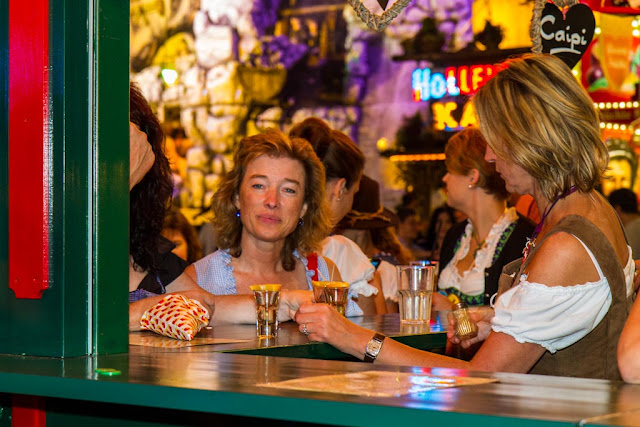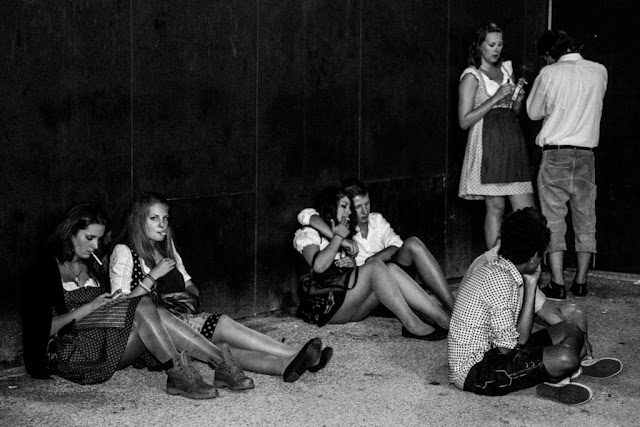The night completely transforms the Oktoberfest, the colours become more vibrant, the crowd much noisier, and the challenge of taking effective photographs becomes far more acute. With this assignment I am doing something I have not done so far in my OCA studies, I using a camera mounted Speedlite. Thus far, I have almost been purist in my desire to work with available light, however, the fest presents new problems that can only realistically be solved using a flash gun. During the day there is significant shadow created by the tents and other buildings, plus the possibility of strong low lying sunlight - a flash can help to lift the lighting of such scenes and add a little extra colour to the foreground people.
At night yet another problem arises, the fest is brilliantly lit, it consumes up to 14% of the city of Munich's electricity supply (a city of over 1.3 million people). Any photograph that I take will be back lit by the fairground and illumination of the beer tents. Once again the solution is camera mounted flash. The night also brings exposure challenges, especially as I am walking around doing what is essentially street photography, good opportunities of people interacting form and dissolve in seconds. I do not have much time to fiddle with exposure. I also need enough shutter speed to freeze the action somewhat. This is a constant balancing act, adjusting ISO, switching from aperture priority to speed priority, always thinking about the scene. I am taking advantage of the fact that I am shooting digital RAW, I have 1 or 2 stops of adjustment in my pocket, although I would prefer not to use them.
As already mentioned the night changes the fest, it increases the tempo and I feel a palpable sense of excitement walking through the milling crowds. As I pass the tents I can hear the roaring of thousands of drinkers singing away to the band - singing is a big part of the experience and really great fun. There is also the real dark side, night also falls as the first really drunk people start to stagger out of the tents not all making their way home. Aggression starts to flare a little, typically late teens posturing and shouting, but sometimes it gets nasty. This is where I start to get quite uncomfortable, I have seen plenty of violence at the fest, a person glassed to the ground with one of the huge beer mugs, blood everywhere, but generally I was also pretty drunk at the time and immune to the threat. I want to capture some of this with my camera, but photographing someone already angry and fighting, hmmm, need to think about that a little.
However, I need to avoid overplaying this element, given how many people go and get drunk there is amazingly little trouble and the security guards are well experienced in dealing with drunken idiots.
A couple of days ago I spent no more than 40 minutes at the fest and shot 60 frames. My interest that evening was in the fair ground and the stalls that surround the event. My first shot, however, was this rather lovely lady enjoying a few additional drinks, she smiled so broadly after I took the shot, nice:
I am thinking of doing a series of images on the booths, they are simply a riot of colour. Clearly I need more in the image for it to work for the assignment, but here are a couple of the more interesting ones.
Another aspect of the fest is the immense fairground and the rides:
The above shot is an experiment and one that worked for me but again is not for the assignment. The next one is a little more appropriate. I wanted to capture groups of people interacting on the rides themselves. I am happy for their to be movement and blur, but it needs to be managed to the degree that we still see the people and their joy or terror. It also will only work at night or dusk as I need the contrast for that.
My second subject of the evening was a look at the darker side of the event, for which I took a trip around the back of the tents where it is a little less well organized. The first shot was this, it works for me:
The next shot is back in the fairground, but illustrates an element of what I need for the set, the end of the evening, fatigue or drunkenness sets in. There is a bit of the Martin Parr about this one, vibrant colour, teenagers being teenagers.
Next are three shots in which I start to bend the rules a little. At the start of my studies with the OCA a very clear mantra was established, do not mix B&W with Colour in an assignment. However, as I advance I now know that rules are made to be broken, but carefully and with intent. One thought I have at the moment is to explore using colour to describe the joy and excitement, but B&W to convey the depths to which people sink. It is not an easy decision and one I will not make until I have completed the shooting phase of the assignment.
B&W also has the advantage of working far better in more marginal light and also obscures some of the more distasteful elements. As an example this "Bierleichen" (beer corpse), was wearing a white shirt stained yellow with his won vomit. He is unconscious, but at least upright and so safer than lying down. The number is roughly his age and the heart reminds us of the bright side of the fest. If there were no constraints on subject matter this would be a strong photo, but the only people he is interacting with are his inner demons and in a few hours the wife his ring finger suggests is probably waiting for him at home. I pity him at so many different levels.
My final two shots are more appropriate for this assignment, the interaction is there. The first one conforms to my own preferred planar view on the world, broken by the man with his hand in his pocket overlooking the scene. The second is just a bunch of people taking it easy after some serious fest going, tired but not out of it.
I feel that I have a developing narrative and it looks at present as if it will describe the stages that people go through at the fest, from the excitement of going to the despair of having gone too much. It will not be a temporal narrative, night and day will intersperse and it will be broadly positive. I love the fest, it really is a wonderful and uplifting event, 99.9% of people have a great time and OK there is the hangover, but no pain no gain. However, a few will end badly and this needs to be captured as well.
After 4 photo shoots, in my mind I can see how the set will develop, but it is not really possible to write this down as a plan beyond what has been said here. Each visit is opportunistic,this is not landscape. I could do this as landscape and then I could plan each shot, the lighting I want, the number of people at the event, and so on. This is Social Documentary, opportunities come and go, at any given time the perfect image always exists, I just might not be there to capture it. I have the day off today, so will be able to spend some quality time with my drunken subjects and then have the weekend to explore further.
Final comment, this is really great fun to photograph, it works best when I try not to think about it too much!











I think it's great that you're enjoying it all so much and this comes through even in the 'hangover' shots. Are you going to mix colour with b+w?
ReplyDeleteNot sure yet on the B&W versus colour, my tutor suggested it which surprised me, but he is very strong on the idea of tying the form to the message, and in the case of the people trashed by the fest B&W works very well. So maybe.
ReplyDeleteI must admit that whilst I am enjoying, it is tiring, both physically and mentally. I have spent very little time at the fest sober, it is much more tolerable after a few beers. Getting walked into or shoved by drunks doesn't faze me when I am one of them, sober it seems a lot more threatening.